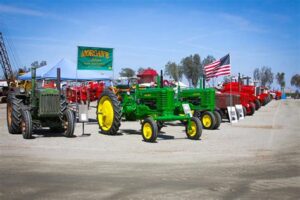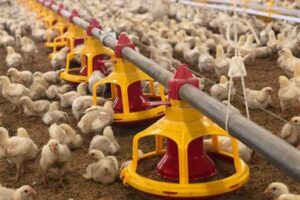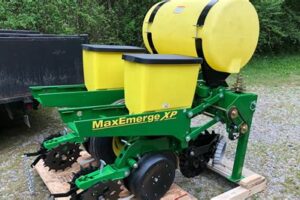Table of Contents
Farm Equipment Combine: Discover the efficient and versatile machinery that revolutionizes harvesting. These powerful combines seamlessly integrate various tasks like cutting, threshing, and cleaning crops in one operation. Enhance your agricultural productivity with our advanced farm equipment combines, designed to handle diverse crops and challenging terrains. Explore our range of innovative features, superior performance, and superior fuel efficiency to optimize your harvest and simplify your farming operations.
When it comes to modern farming, efficiency and productivity are key. And one piece of equipment that has revolutionized the agricultural industry is the farm equipment combine. Combines have transformed the way farmers harvest their crops, allowing them to accomplish in hours what used to take days. With their powerful engines and advanced technology, these machines have become a crucial tool for farmers around the world. But how exactly do combines work, and what makes them so effective? Let’s delve into the inner workings of this remarkable piece of farm equipment and discover the secrets behind its success.
The Evolution of Farm Equipment Combine
The farm equipment combine, also known as a combine harvester, is a versatile and efficient machine that revolutionized the agricultural industry. It has greatly enhanced the productivity and ease of harvesting crops. Combines are used to harvest a variety of grains such as wheat, corn, soybeans, and barley. With their advanced technology and powerful capabilities, they have become an essential part of modern farming practices.
Early Development
The concept of combining the tasks of reaping, threshing, and winnowing into a single machine dates back to the 19th century. The first attempts to create a combined harvester were made in the United States and the United Kingdom. However, it wasn’t until the early 20th century that the design and functionality of the combine became more refined.
Modern Features and Components
Today’s farm equipment combines are equipped with advanced features and components that enhance their efficiency and performance. They consist of a cutting platform, threshing mechanism, cleaning system, grain storage tank, and an unloading system. These components work together to harvest, thresh, separate, and store the grains in an efficient manner.
Improved Harvesting Efficiency
The primary advantage of using a combine harvester is its ability to significantly improve harvesting efficiency. With its wide cutting platform and powerful engine, it can cover a large area of crops in a short amount of time. This reduces labor costs and allows farmers to harvest their crops quickly, even when faced with tight deadlines.
Precise Grain Separation
The threshing mechanism of a combine ensures that the grains are separated from the chaff and straw efficiently. It uses a combination of rotating cylinders and concave bars to separate the grains based on size and weight. This precise separation results in higher grain quality and minimizes losses during the harvesting process.
Advanced Cleaning System
Modern combines are equipped with advanced cleaning systems that remove any remaining debris, weed seeds, and broken grains from the harvested crop. This ensures that the harvested grain is clean and ready for storage or further processing. The cleaning system also helps maintain the longevity and performance of the combine.
Reduced Labor and Time
By automating multiple tasks into a single machine, combines have significantly reduced the need for manual labor during the harvesting process. This not only saves time but also reduces the physical strain on farmers. With a combine, a single operator can efficiently harvest a large area of crops, replacing the need for multiple workers.
Increased Yield and Profitability
The efficiency and precision of combines have led to increased crop yields for farmers. By ensuring that all the grains are harvested and separated effectively, farmers can maximize their yield and profitability. Additionally, the reduced labor costs associated with using a combine contribute to higher overall profitability for farming operations.
Improved Crop Quality
Combines play a crucial role in maintaining the quality of harvested crops. The precise separation, cleaning system, and gentle handling of grains prevent damage and contamination. This results in higher-quality grains that meet market standards and fetch better prices. Improved crop quality also enhances the reputation of farmers and their produce.
Adaptability to Various Crops
One of the greatest advantages of combines is their adaptability to different types of crops. They can be adjusted to harvest various grains with minimal modifications. This flexibility allows farmers to efficiently switch between different crops throughout the year, maximizing their land utilization and diversifying their agricultural practices.
Continued Technological Advancements
The farm equipment combine industry continues to witness technological advancements. Manufacturers are constantly improving the design, efficiency, and automation capabilities of combines. These advancements aim to further enhance productivity, reduce environmental impact, and provide farmers with more precise control over the harvesting process.
In Conclusion
The farm equipment combine has played a significant role in transforming agriculture by increasing efficiency, improving crop quality, and reducing labor requirements. It has become an indispensable tool for modern farmers, allowing them to efficiently harvest and process crops on a large scale. With ongoing technological advancements, the future of combine harvesters looks promising, aiming to further revolutionize the agricultural industry.
Introduction to Farm Equipment Combines
Farm equipment combines are versatile machines used in the agricultural industry to efficiently harvest and process crops, such as wheat, corn, and soybeans. These machines are designed to perform various tasks, including cutting, threshing, separating, and cleaning harvested crops, making them an essential tool for modern farming operations.
Benefits of Using Farm Equipment Combines
The use of farm equipment combines offers numerous advantages to farmers. Firstly, these machines significantly increase harvesting efficiency, allowing farmers to cover larger areas in shorter timeframes. Secondly, combines offer a precise and thorough crop harvesting process, minimizing losses and ensuring a high-quality yield. Lastly, the advanced technology incorporated into modern combines reduces manual labor requirements, improving overall productivity and reducing operational costs.
Key Features and Components of Combines
Farm equipment combines consist of several important components, including the header, threshing drum, sieves, and cleaning system. The header functions as the cutting and gathering platform, while the threshing drum separates the grain from the harvested crops. The sieves and cleaning system help remove impurities and debris from the harvested material, ensuring a clean and market-ready crop.
Types of Combines and their Applications
Farm equipment combines are available in various sizes and configurations, catering to different farm sizes and crop types. Small to mid-sized combines are suitable for smaller farms or for harvesting specialty crops, while larger combines are designed for extensive, high-yield operations. Additionally, specialized combines like rotary combines are used for specific crops, such as rice or lentils, offering enhanced efficiency and performance in those applications.
Maintenance and Care of Combines
To ensure optimal performance and longevity, proper maintenance and care of farm equipment combines are essential. Regular cleaning to remove crop residues, routine lubrication of mechanical parts, and inspection and replacement of worn-out components are crucial for preventing breakdowns and ensuring continued efficiency during the harvesting season.
Trends and Advances in Combine Technology
Farm equipment combines have witnessed significant advancements in technology over the years. These innovations include GPS-guided technology for precise navigation and automatic steering, yield mapping systems to analyze crop performance, and remote monitoring capabilities for real-time diagnostics and troubleshooting. These emerging technologies are revolutionizing the farming industry, improving yields and operational efficiency.
Considerations for Purchasing a Combine
When purchasing a farm equipment combine, farmers should carefully evaluate their specific needs, considering factors such as farm size, crop type, terrain, and budget. It is also crucial to assess the availability of spare parts, ease of maintenance, and the level of after-sales support offered by manufacturers or dealers.
Training and Safety Measures for Combine Operators
Operating farm equipment combines requires specialized knowledge and skills. Proper training programs should be provided to operators to ensure safe and efficient operation. Additionally, safety measures, such as wearing appropriate protective gear, regular equipment inspections, and adherence to maintenance schedules, should be followed to prevent accidents and maintain a safe working environment.
Farm equipment combines are an essential tool for modern agriculture, revolutionizing the way crops are harvested. With their advanced technology and efficiency, combines have become a staple in the farming industry, offering numerous benefits to farmers. Here are some key points highlighting the value of using farm equipment combines:
- Increased productivity: Combines are designed to harvest crops efficiently, allowing farmers to cover more land in less time. Their large cutting widths and high-speed threshing systems enable them to handle a significant amount of crop, resulting in increased productivity and reduced labor requirements.
- Precision harvesting: Combines offer precise control over the harvesting process, ensuring that crops are collected at the optimal time for maximum yield. They are equipped with advanced sensors and monitoring systems that enable farmers to make data-driven decisions, such as adjusting harvesting speed or making crop-specific adjustments based on moisture levels, maturity, and quality.
- Improved grain quality: Combines are equipped with features like sieves and cleaning systems that help separate the grain from unwanted materials, such as chaff and straw. This ensures that the harvested grain is of high quality, minimizing post-harvest losses and maximizing profitability for farmers.
- Reduced crop loss: Combines are designed to minimize crop losses during harvesting. The machines are equipped with header height control systems that adapt to uneven terrain, reducing the risk of crop damage. Additionally, combine headers are designed to efficiently pick up and collect crops, reducing the chances of leaving valuable yield behind.
- Time and cost savings: By combining multiple harvesting processes into a single operation, combines save farmers both time and money. The integration of cutting, threshing, and cleaning systems eliminates the need for separate machinery and reduces fuel and labor costs associated with manual harvesting methods.
- Enhanced versatility: Combines are highly versatile machines that can be used for harvesting a wide range of crops, including cereals, oilseeds, pulses, and even corn. They come with adjustable settings and attachments that allow farmers to adapt the combine to the specific crop and field conditions, making them suitable for diverse farming operations.
- Technological advancements: Modern farm equipment combines are equipped with cutting-edge technology, such as GPS guidance systems, yield monitoring, and automated controls. These advancements enable farmers to optimize their harvest operations, increase efficiency, and make informed decisions, ultimately improving overall farm management.
In conclusion, farm equipment combines have revolutionized the agricultural industry by offering increased productivity, precision harvesting, improved grain quality, reduced crop loss, time and cost savings, enhanced versatility, and technological advancements. These machines have become indispensable tools for modern farmers, allowing them to achieve higher yields, optimize resources, and drive sustainable agricultural practices.
Thank you for visiting our blog and taking the time to learn more about farm equipment combines. We hope that the information provided has given you valuable insights into the importance of this machinery in modern agriculture. In conclusion, farm equipment combines play a crucial role in enhancing efficiency and productivity on farms. These powerful machines have revolutionized the way crops are harvested, making the process faster and more efficient than ever before. By combining multiple tasks into one, farmers can save time and resources, ultimately leading to increased yields and profitability.
One of the key advantages of farm equipment combines is their ability to harvest different types of crops with precision and accuracy. With the use of advanced technology, these machines can adjust settings to accommodate various crop conditions, ensuring maximum output. They also come equipped with sophisticated sensors and monitors that provide real-time data, allowing farmers to make informed decisions regarding yield potential, moisture levels, and quality. This information is invaluable in optimizing operations and maximizing profitability.
Furthermore, the versatility of farm equipment combines cannot be overstated. These machines are not limited to harvesting alone; they can also perform other essential tasks such as threshing, winnowing, and cleaning. This multi-functionality eliminates the need for multiple pieces of equipment, reducing costs and simplifying the overall farming process. Additionally, many combines can be equipped with attachments for specialized tasks such as corn picking or soybean harvesting, further increasing their usefulness and adaptability.
As technology continues to advance, we can expect farm equipment combines to become even more efficient and user-friendly. From autonomous operation to integration with digital platforms, the future of combine technology looks promising. Farmers will be able to remotely monitor and control their machines, analyze data in real-time, and make data-driven decisions for optimal performance. This level of automation and connectivity will undoubtedly revolutionize the agriculture industry and contribute to sustainable and profitable farming practices.
Once again, we appreciate your visit to our blog and hope that you found the information provided both informative and engaging. Farm equipment combines are an essential part of modern agriculture, and understanding their capabilities and benefits is crucial for farmers looking to improve their operations. If you have any further questions or would like to explore this topic in more detail, please feel free to reach out to us. Happy farming!
Video Farm Equipment Combine
1. What is a farm equipment combine?
A farm equipment combine, commonly known as a combine harvester or simply a combine, is a versatile machine used in agriculture to harvest crops such as wheat, corn, soybeans, and more. It combines three essential functions of harvesting: reaping (cutting the crop), threshing (separating the grain from the stalk), and winnowing (cleaning the separated grain).
2. How does a combine harvester work?
A combine harvester works by first cutting the crop using a cutting mechanism, typically a rotating reel or sickle bar. The cut crop then moves onto a conveyor belt that carries it to the threshing section. Inside the threshing section, the crop undergoes a series of processes that separate the grain from the stalk. Finally, the separated grain is collected and stored in a grain tank while the remaining stalks and debris are ejected through the back of the machine.
3. What are the advantages of using a combine harvester?
– Increased efficiency: Combine harvesters can significantly speed up the harvesting process compared to manual labor, allowing farmers to cover large fields in a shorter amount of time.
– Labor savings: By automating the harvesting process, combine harvesters eliminate the need for extensive manual labor, reducing the number of workers required per harvest.
– Improved accuracy: Combines offer precise cutting and threshing capabilities, ensuring minimal grain loss and maintaining the quality of the harvested crop.
– Versatility: Modern combine harvesters are designed to handle various crops, making them a versatile farming tool suitable for different agricultural operations.
4. Are combine harvesters expensive to maintain?
The maintenance costs of a combine harvester can vary depending on factors such as the age of the machine, its condition, and the specific maintenance requirements. While initial investment and some maintenance costs can be significant, modern combines are built to be durable and reliable, reducing the need for frequent repairs. Regular maintenance and proper operation practices can help minimize long-term expenses.
5. Can a combine harvester be used on hilly terrains?
While combine harvesters are primarily designed for flat fields, there are models available that can handle hilly terrains to some extent. These specialized combines often incorporate features such as adjustable leveling systems, terrain compensation mechanisms, and wider tracks to ensure stability and maneuverability on uneven surfaces. However, it’s important to assess the specific terrain and consult with manufacturers or experts to determine the suitability of a combine harvester for hilly areas.






